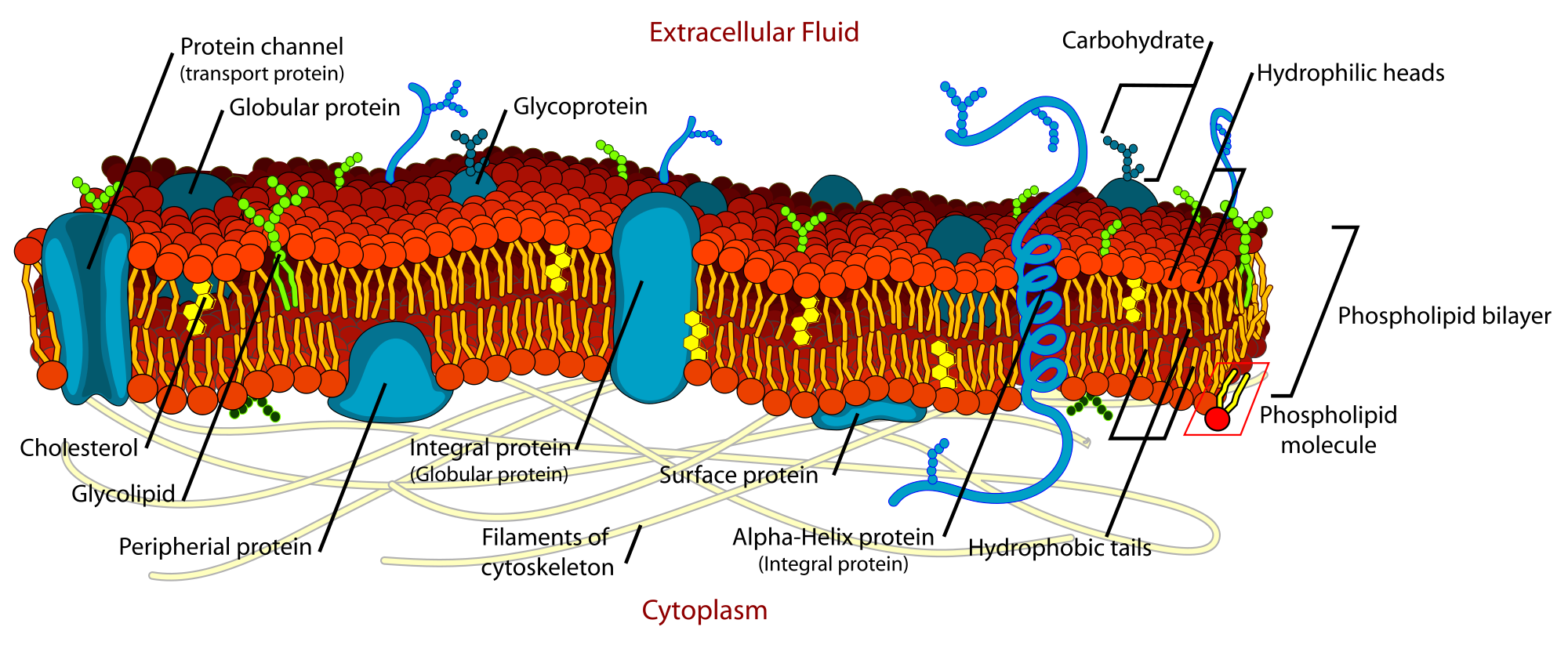Cell Membrane (9/12-9/16)
 |
| https://upload.wikimedia.org/wikipedia/commons/thumb/d/da/Cell_membrane_detailed_diagram_en.svg/2000px-Cell_membrane_detailed_diagram_en.svg.png |
Summary:
This week I learned that the cell membrane is like a bag that keeps all of the parts of the cell inside of it. Another example would be that the cell membrane is like a guard making sure that anybody who enters or exits a building is supposed to be there, and will not cause damage to the cell. It keeps the cell safe inside of it. It also keeps all of the important fluids that the cell will need inside of the cell. The cell membrane also keeps the dirty things that could harm the cell outside.
People usually think that the cell wall is what keeps all of the parts in the cell, but that is not true. Cell walls are only in plants, and they let the plant grow high with enough support so they don't fall.
 The cell membrane is composed of something known as the phospholipid bilayer. The phospholipids have one head, which looks like a red ball, and two tails that look like pieces of hair. The head is polar, and hydrophilic (known as "water loving") and the tails are known as non-polar, and hydrophobic (known as "water fearing.") There is a lot of water surrounding the cells, so this is why the heads form in two layers facing towards the outside. The tails stay hidden in the middle of the cell membrane.
The cell membrane is composed of something known as the phospholipid bilayer. The phospholipids have one head, which looks like a red ball, and two tails that look like pieces of hair. The head is polar, and hydrophilic (known as "water loving") and the tails are known as non-polar, and hydrophobic (known as "water fearing.") There is a lot of water surrounding the cells, so this is why the heads form in two layers facing towards the outside. The tails stay hidden in the middle of the cell membrane.
The cell membrane is also made up of cholesterol molecules that help stabilize the phospholipids in place, and position. There are also a lot of proteins dotting the cell membrane. These proteins are called peripheral proteins, and integral proteins. The peripheral proteins only go halfway through the membrane, and the integral proteins go completely through the membrane. These proteins are like "channels" that allow molecules to enter and leave the cell.
The cell membrane works with the rough and smooth endoplasmic reticulum (ER.) The ER processes the proteins, and then the cell membrane takes them and uses them the help the cell, and so the molecules can enter and leave the cell
 The cell membrane is composed of something known as the phospholipid bilayer. The phospholipids have one head, which looks like a red ball, and two tails that look like pieces of hair. The head is polar, and hydrophilic (known as "water loving") and the tails are known as non-polar, and hydrophobic (known as "water fearing.") There is a lot of water surrounding the cells, so this is why the heads form in two layers facing towards the outside. The tails stay hidden in the middle of the cell membrane.
The cell membrane is composed of something known as the phospholipid bilayer. The phospholipids have one head, which looks like a red ball, and two tails that look like pieces of hair. The head is polar, and hydrophilic (known as "water loving") and the tails are known as non-polar, and hydrophobic (known as "water fearing.") There is a lot of water surrounding the cells, so this is why the heads form in two layers facing towards the outside. The tails stay hidden in the middle of the cell membrane. The cell membrane is also made up of cholesterol molecules that help stabilize the phospholipids in place, and position. There are also a lot of proteins dotting the cell membrane. These proteins are called peripheral proteins, and integral proteins. The peripheral proteins only go halfway through the membrane, and the integral proteins go completely through the membrane. These proteins are like "channels" that allow molecules to enter and leave the cell.
The cell membrane works with the rough and smooth endoplasmic reticulum (ER.) The ER processes the proteins, and then the cell membrane takes them and uses them the help the cell, and so the molecules can enter and leave the cell
Comments
Post a Comment